I Use Summon Undead 5e to Dominate D&D Campaigns
Ever wondered how a single spell can turn the tide of an entire battle? For me, the answer lies in Summon Undead 5e. This necromancy spell isn’t just about raising minions—it’s about strategy, creativity, and dominating the battlefield with undead allies.
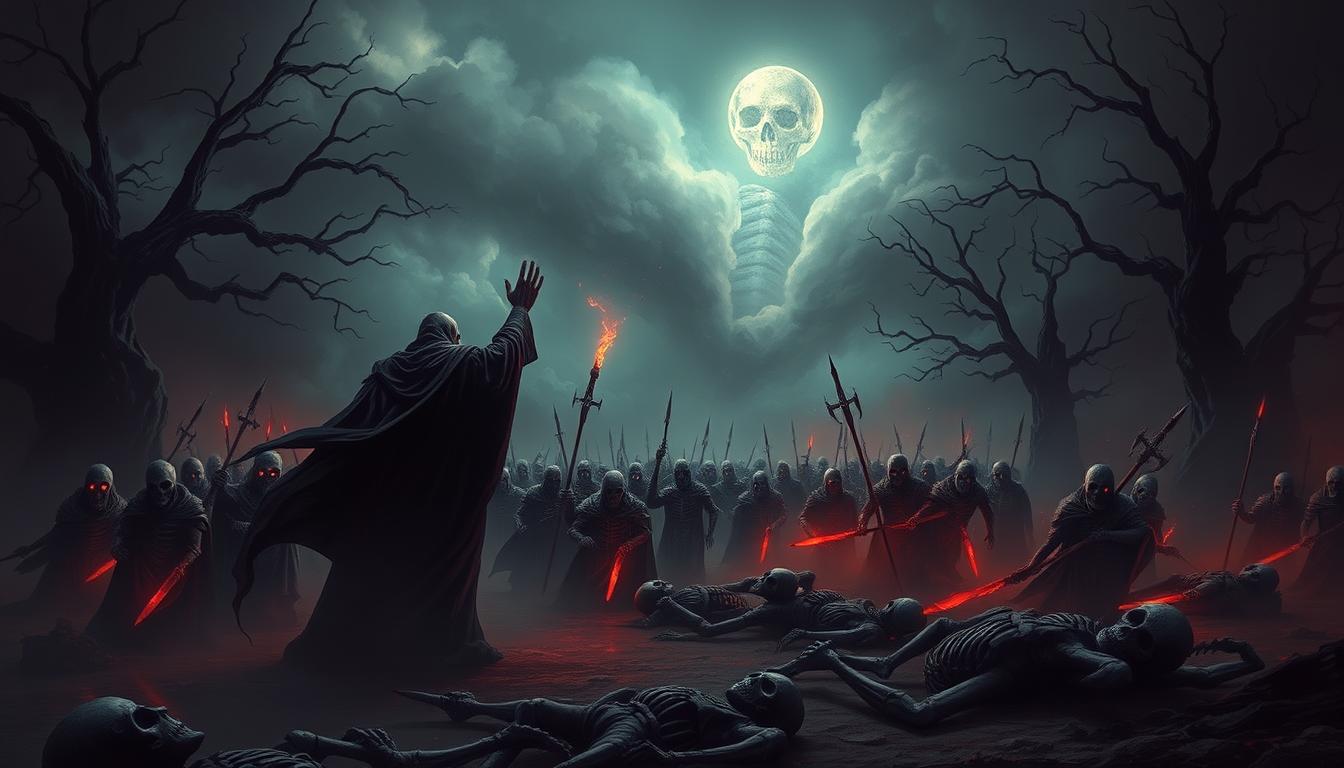
From controlling the flow of combat to adding depth to roleplay, this spell has been my secret weapon in countless campaigns. Whether you’re a seasoned necromancer or just starting, mastering it opens doors to tactical advantages and unforgettable storytelling moments.
In this guide, I’ll break down the mechanics, best creature choices, and advanced synergies—all backed by real campaign experience. Ready to unleash the full potential of your dark magic?
Key Takeaways
- Strategic Power: The spell offers unique combat control and flexibility.
- Roleplay Depth: Undead minions can enrich your character’s story.
- Mechanics Mastery: Learn how to optimize spell usage for maximum impact.
- Creature Selection: Choose the right minions for different scenarios.
- Real Campaign Tips: Insights from actual gameplay to avoid common pitfalls.
Why Summon Undead 5e Is My Go-To Spell
Not all spells give you the same tactical edge—this one changes everything. While other wizard options force rigid choices, this spell adapts to any fight. Need a tank? Summon a skeletal brute. Prefer crowd control? A ghoul’s paralysis does wonders.
- No concentration checks: Unlike *Create Undead*, your minions won’t turn on you mid-battle.
- Fresh creatures every cast: Swap a zombie for a specter based on the enemy’s weaknesses.
- Low upkeep: No daily recasts like *Animate Dead*—just point and unleash.
Compare it to *Conjure Animals*, and the differences are stark:
| Feature | Summon Undead | Conjure Animals |
|---|---|---|
| Casting Time | 1 action | 1 minute |
| Control | Automatic | Concentration checks |
| Creature Variety | Scales with level | DM-dependent |
For necromancers, it’s also a storytelling goldmine. My skeletal archer once delivered a villain’s final blow—campaign lore for years. Whether you’re optimizing combat or crafting a dark legend, this spell delivers.
How Summon Undead 5e Works: Spell Mechanics Explained
Spellcasting isn’t just about power—it’s about precision and timing. To dominate with this necromancy spell, you need to understand its core mechanics. Let’s break down the essentials.
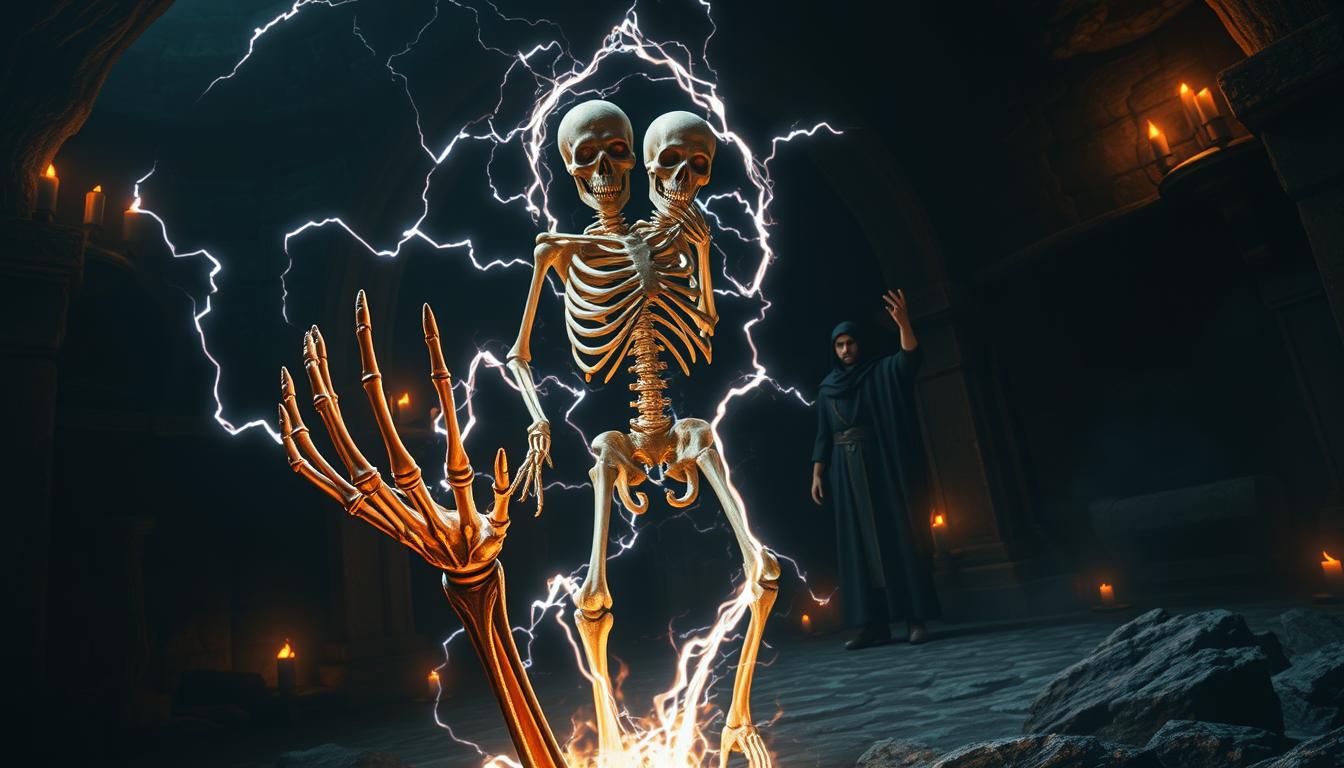
Casting Time and Components
This spell shines with its 1-round casting time. Unlike *Create Undead* (1 minute), you can deploy minions mid-battle. It requires V/S/DF components—a carved bone focus replaces *Create Undead*’s clay pots.
Duration and Control
Your undead ally lasts 1 round per caster level. No concentration checks mean no surprises. Use command actions wisely—positioning minions strategically maximizes their impact.
Spell Slot Requirements
Scaling is straightforward:
| Spell Slot | Benefit |
|---|---|
| 1st | Basic skeletons/zombies |
| 3rd | Ghouls with paralysis |
| 5th | Mummies with fear aura |
Pro tip: Upcasting at higher levels unlocks deadlier creatures without extra command actions.
Best Undead Creatures to Summon by Level
Choosing the right minions can make or break your necromantic strategy. Each level unlocks unique creatures with strengths tailored for different fights. Below, I’ll break down the top picks—from early-game tanks to late-game terrors.
1st-Level Summons: Human Warrior Skeleton and Kobold Zombie
The Human Warrior Skeleton trades HP for precision. Its +4 to attack rolls makes it a reliable damage dealer. Need a meat shield? The Kobold Zombie soaks hits with 22 HP but struggles to land blows.
2nd-Level Summons: Owlbear Skeleton and Bugbear Zombie
An Owlbear Skeleton hits like a truck (2d8+4 damage), while the Bugbear Zombie offers 45 HP for holding choke points. Trade damage for durability based on your party’s needs.
3rd-Level Summons: Ghoul and Troll Skeleton
Ghouls paralyze foes (DC 12 Con save), but their 22 HP melts fast. Pair them with a Troll Skeleton—its regeneration (10 HP/round) makes it a frontline staple.
| Creature | HP | Key Ability | Best For |
|---|---|---|---|
| Ghoul | 22 | Paralysis | Crowd control |
| Troll Skeleton | 84 | Regeneration | Tanking |
| Allip | 40 | Wisdom Drain | Mage hunting |
4th-Level Summons: Allip and Ghast
Allips cripple casters with Wisdom drain, but avoid sunlight. Ghasts upgrade ghouls with +2 DC on paralysis and stench auras.
5th-Level Summons: Mummy and Shadow
A Mummy’s gaze paralyzes (DC 12 Wis), and DR 5/bludgeoning shrugs off attacks. Shadows drain Strength but evaporate in daylight—plan accordingly.
Pro tip: Always check the battlefield. Sunlight vulnerabilities can turn your creatures to dust mid-fight.
Strategic Uses for Summon Undead in Combat
Battlefields are chaotic, but the right strategy can turn disorder into domination. This spell shines when you treat your creatures as chess pieces rather than mindless attackers. I’ve turned losing fights into victories by mastering these tactical approaches.
Frontline Tanks vs. Utility Minions
Not all undead serve the same purpose. A Bugbear Zombie with 45 HP can shield your wizard, while a Ghoul paralyzes priority targets. Here’s how I choose:
- Living shields: Position zombies to absorb attack rolls meant for allies
- Action economy: Pre-cast before initiative to save your first turn
- Zone control: Block corridors with large skeletons to limit enemy movement
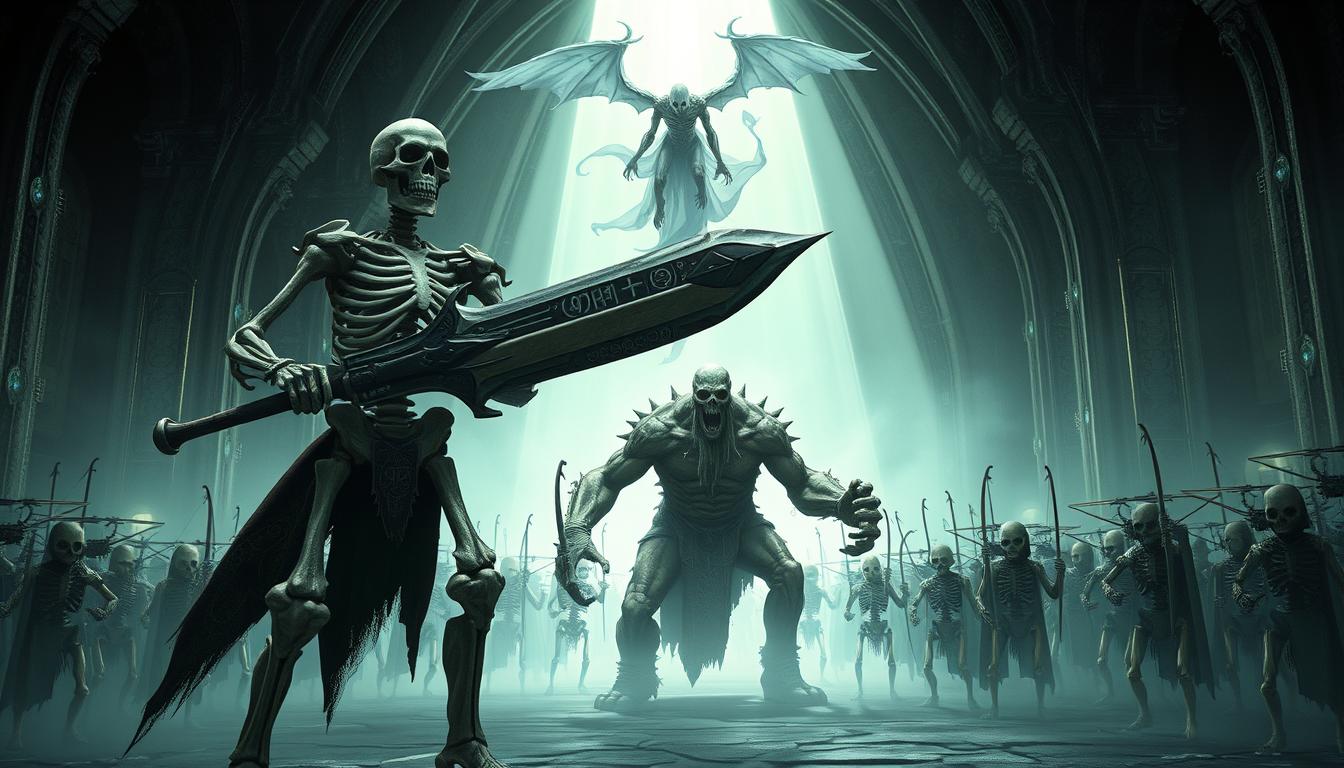
Combining Summons with Other Spells
The real magic happens when spells work together. My favorite synergies:
| Combo | Effect | Best Against |
|---|---|---|
| Ghast + Web | Enemies stuck in webs suffer stench penalties | Melee attackers |
| Shadow + Darkness | Strength drain in obscured areas | High-CR brutes |
| Mummy + Fear | Stacked Wis saves overwhelm foes | Casters |
Remember: Use a bonus action to reposition minions after casting area effects. This creates overlapping threats that overwhelm enemies.
Maximizing Your Summon Undead 5e Spell Slots
Managing your magical resources separates good casters from legendary ones. Every spell slot counts when commanding the dead. I’ve learned through hard fights that smart allocation beats brute force every time.
When to Upcast for Better Creatures
Upcasting transforms basic skeletons into nightmare fuel. At 3rd level, ghouls gain paralysis—perfect for locking down key targets. But is it worth burning higher slots?
Consider these trade-offs:
- Four 1st-level zombies can surround enemies but lack special abilities
- One 4th-level ghast delivers crowd control with its stench aura
- 5th-level mummies become panic buttons against boss fights
Balancing Summons with Other Spell Needs
I always keep one 5th level slot reserved for emergencies. When the dragon appeared unexpectedly, my mummy’s fear aura saved the party. Here’s my daily spell budget approach:
- Morning: Ritual cast detection spells to conserve slots
- Standard encounters: 1st-3rd level summons
- Boss fights: Break glass with 7th-level spell slot terrors
Multiclassing expands options dramatically. My wizard/cleric hybrid uses channel divinity to stretch dark magic further. Pairing Unseen Servant rituals with active summons creates deceptive battlefield presences.
Remember: Your best undead aren’t always the strongest—they’re the right ones at the right moment.
Roleplaying with Summoned Undead
Dark magic isn’t just about power—it’s about the stories you tell with it. Whether you’re a necromancer or a cleric dabbling in shadows, your minions can deepen your campaign’s lore. Here’s how to make them unforgettable.
Flavoring Your Creatures for Campaign Themes
Reskinning is your best friend. In a frozen wasteland? Turn wraiths into ice specters with frostbite auras. Urban espionage? Use Mask of Many Faces to disguise skeletons as beggars.
Pro tip: Always check your DM’s page for homebrew rules. Some allow undead with plant or elemental traits for unique themes.
Handling NPC Reactions to Your Undead
Not everyone welcomes the walking dead. In cities, I’ve used Deception (“They’re just… very pale”) or Intimidation to avoid guards. For paladin allies, I frame my creatures as “redeeming evil through service.”
- Ethical sourcing: Use bandit corpses to avoid moral dilemmas.
- Command wisely: A ghoul’s growl can scare NPCs—or rally them if you’re fighting demons.
Remember: Creativity trumps brute force. A well-roleplayed minion often outshines the strongest spell.
Advanced Tactics: Summon Undead in High-Level Play
When the stakes rise, your dark magic must evolve beyond basic minions. At higher tiers, every 7th-level spell slot becomes a strategic weapon—not just a resource. I’ve turned endgame bosses into puppets by mastering these advanced techniques.
Using 7th-Level Spell Slots for Maximum Impact
Burning high-level slots isn’t wasteful—it’s surgical. With Create Undead, one slot commands four ghouls. But raw numbers aren’t everything. Here’s how I prioritize:
| Option | Advantage | Best Scenario |
|---|---|---|
| Single mummy | Fear aura + 45 HP | Boss fights |
| Ghoul pack | 4 paralysis attempts | Swarming melee foes |
| Allip duo | Wisdom drain stacking | Against clerics |
Pro tip: Pair ghouls with Web spells. Paralysis in difficult terrain wins battles instantly.
Synergies with Necromancer Class Features
As a wizard specializing in death, your features multiply effectiveness:
- Grim Harvest: Heal when zombies die—perfect for kamikaze rushes
- Undead Thralls: Boost Allip’s Wisdom drain DC by +2
- Inured to Undeath: Ignore your own mummy’s despair aura
For cheese lovers: Simulacrum doubles your summon capacity. Just don’t anger your DM.
Always have a Dimension Door ready. When minions collapse, teleport behind fresh corpses to restart the cycle.
Common Mistakes to Avoid with Summon Undead 5e
Even seasoned necromancers can stumble when commanding the restless dead—here’s how to avoid costly errors. From mistimed spells to brittle minions, I’ve learned these lessons the hard way so you don’t have to.
Overextending Your Control Limits
Timing is everything. I once lost a ghoul pack mid-battle because I forgot their 1-hour duration expired. Now I track rounds like a hawk:
- Multi-encounter days: Minions vanish if you don’t recast before resting
- Action economy: Wasting turns micromanaging weak skeletons hurts more than it helps
- Concentration traps: Casting Hold Person while commanding undead? Prepare for both to fail
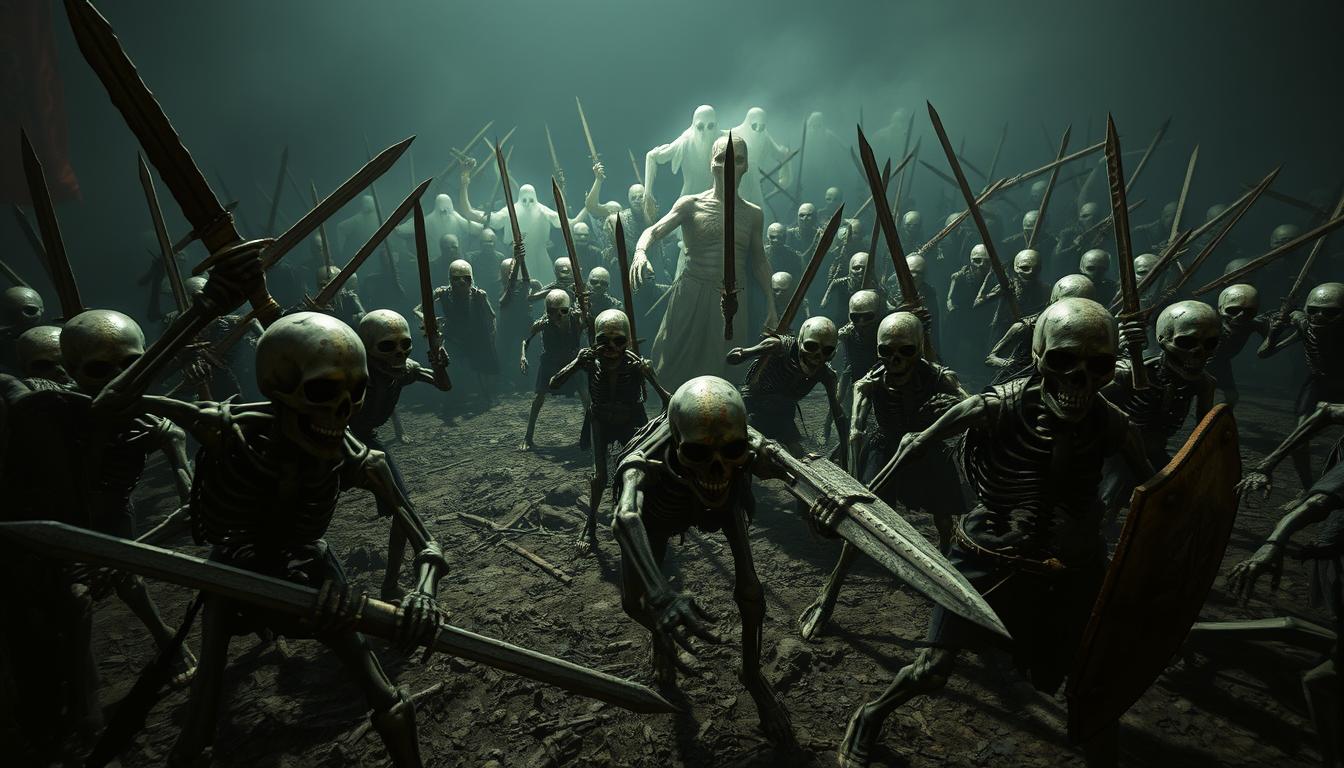
Misjudging Creature Durability
Not all bones are created equal. A shadow’s 40 HP looks decent—until you realize its 12 AC melts against multi-attacks. Key survival tips:
| Creature | Weakness | Fix |
|---|---|---|
| Zombies | Low AC | Use cover or Shield of Faith |
| Ghouls | Sunlight | Night raids only |
| Mummies | Fire vulnerability | Keep away from saving throw spells |
Pro tip: Always check the battlefield. That open plain might give your creatures one attack before sunlight turns them to ash.
Comparing Summon Undead to Other Summoning Spells
Summoning magic comes in many forms, from temporary allies to permanent servants. While they all create additional combatants, the differences in flexibility, control, and roleplay potential are dramatic. Here’s how the options stack up in real gameplay.
Summon Undead vs. Conjure Animals
The action economy difference is stark. Conjure Animals requires a full minute to cast—useless when arrows start flying. My undead minions, however, appear in seconds during heated battles.
Creature types matter too. Beasts excel at scouting and mobility, but undead ignore charm effects and poison. I’ve watched wolves flee from fear auras while skeletons march onward.
| Factor | Summon Undead | Conjure Animals |
|---|---|---|
| Casting Time | 1 action | 1 minute |
| Immunities | Poison, charm | None |
| Utility | Combat focus | Scouting options |
Summon Undead vs. Create Undead
Permanent minions sound great until you need different tools. Create Undead locks you into your initial choices, while I can adapt my forces each encounter. No wasted onyx components either.
The roleplay implications differ too. Townsfolk tolerate temporary spirits more than permanent ghouls following you. My rule? Match your spell choice to your campaign’s tone.
For dungeon crawls, I prefer flexibility. But in necromancer-heavy stories, permanent servants add depth. Just be ready for the consequences when your creations outlive their welcome.
DM Tips: How to Handle Players Using Summon Undead
Every DM faces unique challenges when players master dark magic—here’s how to keep the game balanced. Whether it’s a necromancer’s horde or a cleric’s spectral ally, these strategies ensure fun for everyone.
Balancing Encounters Around Minions
Action economy swings hard with extra combatants. Instead of nerfing spells, tweak encounters:
- Anti-necromancer foes: Sun clerics with Turn Undead or paladins with radiant damage.
- Terrain traps: Narrow corridors limit hordes, while sunlight weakens shadows.
- Smart enemies: Bandits might flee from mummies but ambush the caster first.
Pro tip: Prep a monster manual cheat sheet for quick undead counters. No one likes mid-session page-flipping.
Rewarding Creative Undead Usage
Great roleplay deserves recognition. Try these incentives:
- Thematic magic items: A bone amulet that buffs skeletal archers.
- Story hooks: A ghostly ally reveals hidden lore if treated respectfully.
- Session zero talks: Clarify evil-aligned magic limits early (per player handbook guidelines).
Example: My player’s zombie horde once carried a bridge’s rubble—earning inspiration for creative problem-solving.
Essential Gear for Summon Undead Specialists
The right tools transform good necromancers into unstoppable forces. While spells provide power, your equipment determines how efficiently you wield it. I’ve learned through countless campaigns that smart gear choices make all the difference.
Must-Have Wizard Components
Your wizard components are the foundation of dark magic. A carved bone focus works better than generic materials—it resonates with necrotic energy. I always carry an unlit black candle too, perfect for dimly lit rituals.
- Quick-access slots: Keep bones and candles in separate pockets for fast casting
- Backup materials: Carry extra grave dirt in wax-sealed vials
- Thematic touches: Use mummified fingers as pointers for intimidation checks
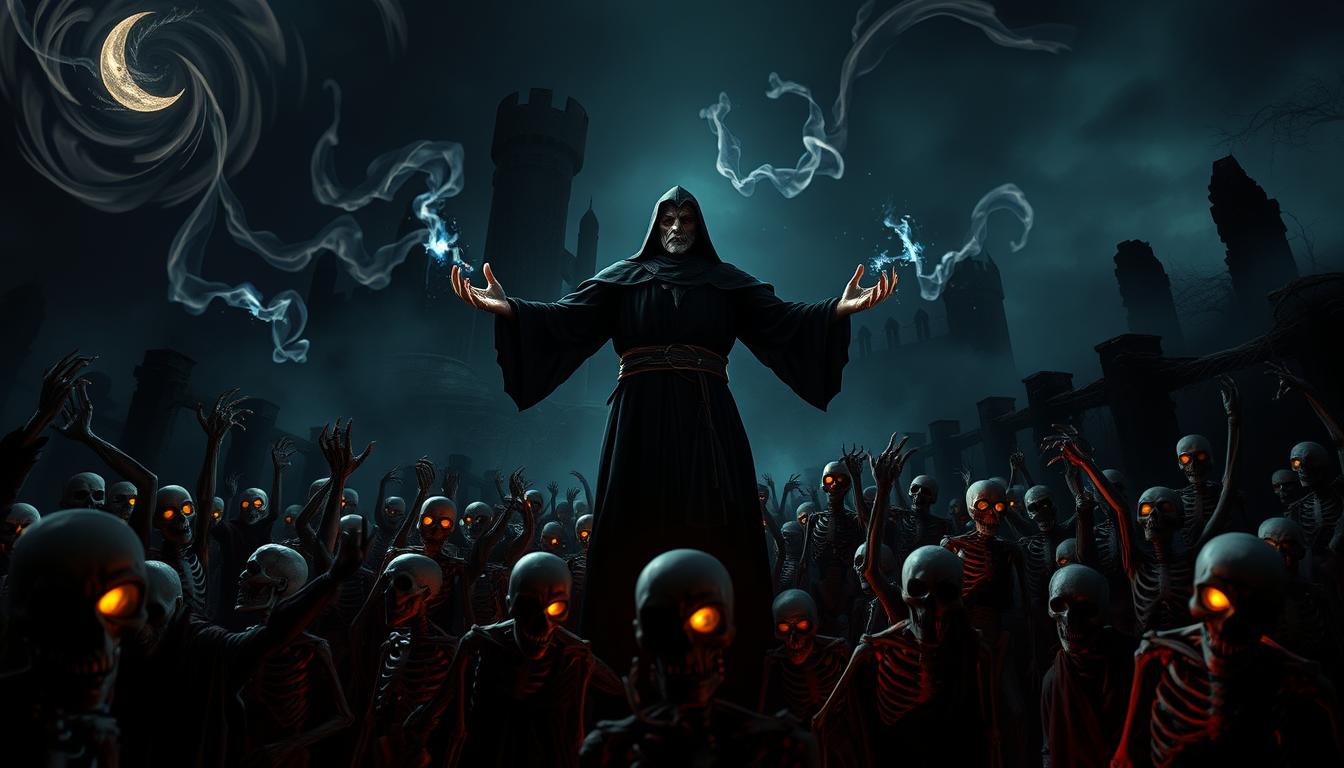
Magic Items That Boost Your Undead
The right magic items multiply your effectiveness. My Necromancer’s Grimoire adds +2 to spell attack rolls, while a Wand of the War Mage improves accuracy. For defense, nothing beats Armor of Necrotic Resistance when minions turn on you.
Creative solutions matter too:
- Bag of Holding: Store fresh corpses for emergency casting
- Amulet of Undead Control: Homebrew item granting advantage on command rolls
- Boots of False Life: Extra HP when your tank minions fall
| Item | Benefit | Best Pairing |
|---|---|---|
| Necromancer’s Grimoire | +2 spell attacks | Ghoul paralysis attempts |
| Armor of Necrotic Resistance | Half damage from undead | Close-quarters control |
| Bag of Holding | Corpse storage | Urban campaigns |
Remember: Your gear should complement your playstyle. A frontline necromancer needs different tools than a backline controller.
Building a Character Around Summon Undead 5e
Your character build determines how deadly your dark magic becomes. I’ve played everything from wizard specialists to cleric hybrids—each approach offers unique advantages. The right combination of class, race, and feats transforms this spell from good to game-breaking.
Best Classes and Subclasses
Not all necromancers are created equal. Through trial and error, I’ve found these options deliver the most power:
| Class | Strength | Weakness |
|---|---|---|
| Death Domain Cleric | Channel Divinity boosts damage | Limited spell flexibility |
| Oathbreaker Paladin | Aura buffs undead attacks | Alignment restrictions |
| Necromancy Wizard | Grim Harvest sustains you | Squishy frontline |
The Death Domain shines for raw damage. My level 6 cleric could nova with Touch of Death plus spiritual weapon. But Oathbreakers offer better survivability—their aura gives +4 damage to all nearby minions.
Feats That Complement the Spell
Smart feat choices patch weaknesses in your build. These are my must-haves:
- Resilient (CON): Protects concentration when minions tank hits
- War Caster: Lets you command undead while wielding a shield
- Alert: Ensures your ghouls act before enemies move
For multiclass builds, I often take a 1-level wizard dip on clerics. This grants access to Shield and Absorb Elements—crucial for surviving frontline combat.
Racial choices matter too. Hobgoblins get free armor proficiency, while Vedalken’s advantage on mental saves protects your control. My current warlock uses Undying Servitude invocation to stack summons with pact magic slots.
Remember: Your build should match your playstyle. Glass cannon or tanky commander—both work with the right choices.
Homebrew Ideas to Enhance Summon Undead
Customizing your dark magic toolkit can elevate your gameplay beyond standard rules. While the spell offers great flexibility, creative tweaks make it unforgettable. I’ve worked with DMs to develop these homebrew concepts that maintain balance while adding flair.
Custom Undead Creatures
The monster manual is just a starting point. Try these templates I’ve playtested:
- Skeletal Mage: Grants cantrip attacks (1d6 necrotic) at 4th level slots
- Swarm Variants: Use Stirge stats for locust-like bone clouds
- Lich Patron Minions: Expanded spell lists for intelligent undead
Reskinning works wonders too. My pirate campaign featured barnacle-covered drowned ones instead of zombies. Always match your creatures to the campaign’s aesthetic.
Alternative Control Mechanics
Standard commands get repetitive. These house rules add depth:
- Sacrifice System: Burn hit dice to boost minion stats for one encounter
- Death Explosions: Corpses detonate for 1d6 damage per spell level
- Bonded Servitude: Permanent undead that degrade without weekly maintenance
For high-risk games, I’ve used a corruption mechanic—each summoning roll adds to a hidden madness track. The more you push limits, the stranger your creatures become.
Real Campaign Stories: Summon Undead in Action
Nothing proves a spell’s worth like real battlefield moments—here are mine. Through years of play, I’ve learned that theory means little until tested against actual enemies. These stories show how creative tactics turn dark magic into campaign-saving plays.
The Perfect Time for a Ghoul
Our party faced annihilation against a vampire lord in Castle Darkhold. With the paladin down and cleric out of spells, I waited for the boss to lunge—then unleashed a ghoul from hiding.
The paralysis landed on a natural 1 save. What followed became legendary:
| Round | Action | Result |
|---|---|---|
| 1 | Ghoul appears behind vampire | Surprise advantage gained |
| 2 | Paralysis attempt (DC 12) | Vampire fails save |
| 3 | Rogue sneak attack | 48 damage (coup de grâce) |
This taught me to hold minions in reserve for time-sensitive moments. Now I always keep one slot ready for emergency plays.
When Zombies Became Our Wall
During Tomb of Annihilation’s infamous kobold ambush, our spellcasters were cornered. With a whispered incantation, six shambling creatures formed a living barricade.
The results stunned even our DM:
- Round 1: Kobold arrows wasted on 22 HP zombies
- Round 2: Frontline fighters regrouped behind the meat shield
- Round 3: Fireball cleared the now-stationary attackers
Sometimes the simplest creatures create the most brilliant solutions. That day, basic zombies saved us from a TPK.
Conclusion: Mastering Summon Undead 5e for D&D Dominance
Dominating the battlefield with dark magic comes down to three pillars: preparation, adaptation, and execution. Whether you’re using ghouls for crowd control or mummies for fear effects, the right creatures at the right time win fights.
Don’t be afraid to experiment. Mix and match minions based on enemy weaknesses. A skeletal archer works great against flying foes, while shadows excel in dim dungeons.
Remember to keep the game fun for everyone. Talk with your DM about balance and creative uses for your spell. The best moments come from teamwork, not just raw power.
For updates on new stat blocks, check official sources like D&D Beyond. Now go forth—share your own dark magic stories and reshape your campaigns!